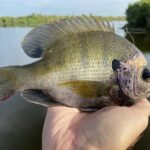Summers are a time of abundance…the fishing is good, and the bait is plentiful.
But what about the winter?
If you’ve ever tried catching your own minnows during the colder months, you may have been wondering where do minnows go in the winter?
Well, there is an explanation and that’s what I’m going to discuss in this article.
Table of Contents
Where Do Minnows Go in the Winter?
Similar to other species of fish, minnows will decrease their activity significantly during the winter months. During these states of inactivity, minnows attempt to stay hidden from predator fish. They tend to hide in underwater plants, rocks, and other structures during the changing seasons.
While larger fish like salmon and bass are known for migrating great distances as the season changes, minnows will generally stay put during the winter months.
Minnows gravitate toward safer and more protected areas to hide and take cover during the winter months.
Another place minnows will congregate is near inlets from nearby streams that feed into lakes.
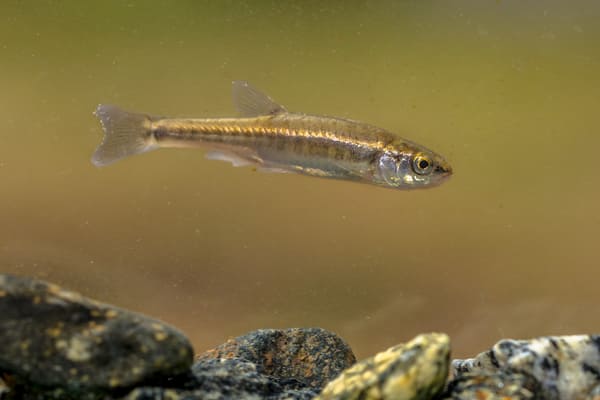
When lakes get colder, especially during freezing, the oxygen content in the water begins to drop. These streams provide a boost of oxygen for the minnows as it feeds into the lake.
Most predator fish will dive deep into the water during the winter in search of warmer waters. For this reason, minnows will generally stay in shallower areas and avoid deeper water. While the water is colder in these areas, the predator fish down below keep them from joining.
See Also: Minnows vs Shiners: Understanding The Difference
Common Shiners and Emerald Shiners are among the largest fish in the minnow family, making it a bit tougher for them to take cover in vegetation during these colder months. They tend to stick near larger structures like stump fields, submerged trees and rock piles.
How Do Minnows Survive the Winter?
Minnows are poikilothermic, meaning that their body temperatures vary based on their surroundings. This also means that they can not regulate their own body temperatures without decreasing activity, which slows their metabolisms and lessens the need for feeding.
The winter months are the period of least activity for minnows, and the name of the game is surviving the winter while expending as little energy as possible.
By decreasing activity, the minnows use less energy, and their need to feed lessens.
Not having to swim significant distances throughout the day in search of food allows the minnows to take cover in rock formations and other underwater hiding places.
Most species of minnow only live 1-2 years, so they wait until the warmer months to spawn, as the eggs require warmer temperatures for survival.
Surviving the winter is a delicate balancing act for minnows, as they have to juggle three main threats –water temperature, oxygen content, and predators during these months.
While the surface of the water is safer from predators, it is significantly colder near the surface than deeper below. Minnows must stay deep enough to avoid freezing while staying shallow enough to avoid predators and oxygen deprivation.
Minnows often rely on streams to oxygenate the water and can be found in the general vicinity where they feed into the lake.
Mud minnows take a different approach, as they have evolved to be able to breathe the oxygen trapped in small bubbles beneath the ice’s surface.
Can You Catch Minnows in the Winter?
While they will be less active during the winter months, minnows can be caught during the winter. Methods like cast netting and dip netting will be less effective, as they will be harder to spot moving in schools. Minnow traps are the best way to catch minnows in the winter.
Cast nets are usually the quickest way to capture a significant amount of minnows in a short period of time, but during the winter months, it is less likely that an angler will come across an active school of them within throwing distance.
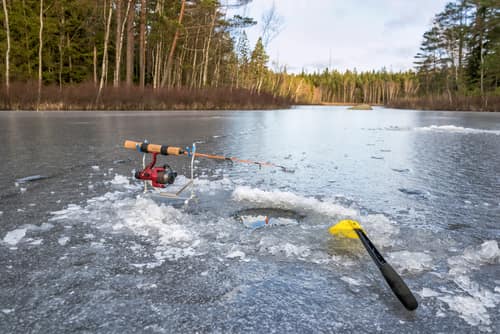
Minnow traps are the best options during the winter months, though they may take a bit more time to fill up than in the spring or summer.
Traps should also be filled with extra pungent and smelly bait during these months to try and attract more minnows.
How Do You Catch Minnows in the Ice?
Catching minnows in the ice requires only a couple more tools than catching them during the winter months. Break a hole in the ice using a drill or auger, and lower a minnow trap into the ice-filled with a pungent bait. Secure the trap’s line to a fixed object, or use a buoy to retrieve the trap.
Many anglers will drill a hole and set a minnow trap one or two days before they plan on fishing. That way the traps have time to fill up, and the bait fish are fresh upon arrival.
This is a great technique and an example of how proper planning can increase the chances of landing fish!
You May Also Like: Do Catfish Bite in Cold Weather? (And How To Find Them!)
If you haven’t guessed yet, I love fishing and everything about it!
To learn more about why I started Panfish Nation, visit the About page and follow along on Social Media:


Download a copy of my FREE Lure Color Selection Chart & Knot Guide!
Stay up to date with fishing reports, tackle reviews, industry news, and much more! We respect your privacy, unsubscribe at any time.
Related Posts
- Crazy Facts About the World Record Crappie

- What Size Hooks for Smallmouth Bass? Quick Guide

- Large and in Charge-Mouth: 10 of the Best Bass Lures of All Time (And Where to Buy Them)

- Emperor of the Sun(fish): What You Need to Know About the World Record Bluegill
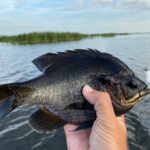
- Coppernose Bluegills: How They’re Different from Common Bluegill
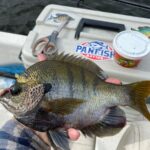
- Bluegill vs Brim: Differences & Terminology, Explained!
